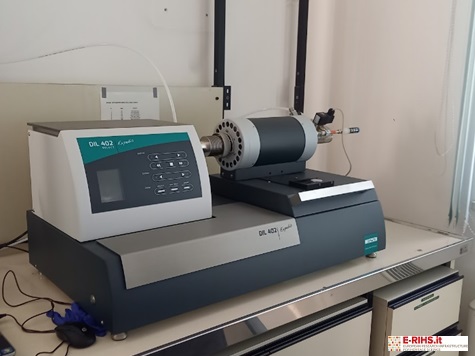
LABORATORY CNR ISPC: Stone LAB
NAME OF THE INSTRUMENT
Thermal Dilatometers (DIL 402 Expedis Select Netzsch, GT1170 Gabrielli Technology)
GENERAL DESCRIPTION
The instrumentation includes two equipments for measuring dimensional changes of materials with temperature. The first is a DIL 402 Expedis Select Netzsch dilatometer, suitable for measuring dimensional changes of small samples (up to 52 mm in length and 19 mm in diameter). The second equipment (GT1170 Gabrielli Technology) is used for larger samples following UNI EN 14581 for thermal expansion measurements on stone materials.
TECHNICAL description: DIL 402 EXPEDIS SELECT NETZSCH:
- Horizontal "pushrod" technology with a single measuring system
- Automatic determination of initial sample length
- Capable of operating on specimens between 1 and 52 mm in length and 12 mm (or 19 mm) in diameter
- Measuring range from -10 mm to +10 mm
- Contact force adjustable in the range from 10mN to 3N
- Length measurement Resolution: 1nm
- Temperature range from 0°C to 1000°C
- Able to operate in an inert atmosphere or air.
DIL 402 EXPEDIS Select Netzsch is equipped with an optoelectronic sensor that enables automatic measurement of sample size. This feature is useful in the case of irregularly shaped specimens since it avoids the use of other measuring equipment, a possible source of error. The equipment is also equipped with a variable force specimen contact system so that even fragile or soft materials can be analyzed.
TECHNICAL DESCRIPTION: DILATOMETER GT1170 Gabrielli Technology
- Sistema di misura meccanico per rilevare la variazione della distanza tra due cilindri (K=13,5×10 ¯ ⁶da 20°C e 80° C)
- Termometro digitale con due canali per termocoppia K
In the case of the GT1170 dilatometer, the test consists of placing the 250x50x20 mm specimen in a temperature-controlled cell (gradient 0.2°C /min) to perform the thermal cycle. Measurement of the length of the specimen is done manually with a mechanical dial indicator (1/1000 resolution of the length to be measured) at 20°C and 80°C (if necessary every 20°C).
Referent:
Emilia Vasanelli emilia.vasanelli@cnr.it
